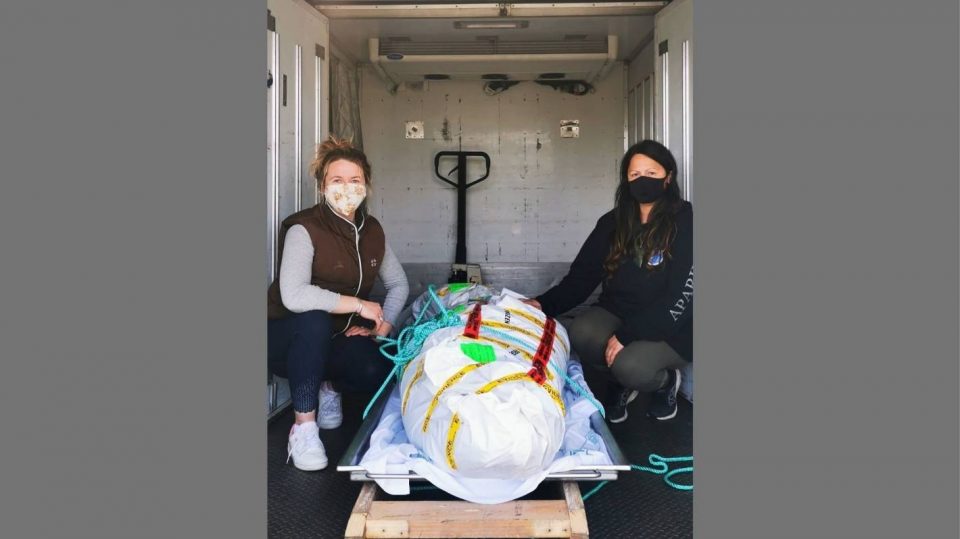It’s a bizarre story involving a pet crematorium, a decommissioned hospital mortuary, a 280kg sea mammal, and a group of Southlanders who became citizen scientists overnight.
And it all started when a mystery person notified LeopardSeals.org that a deceased leopard seal had washed up on Oreti Beach, late in 2021, some 750kms away from the organisation’s marine scientists.
But with the mammal’s blubber holding valuable information about its life and how it ended up in Southland, LeopardSeals.org co-founder and marine scientist Dr Krista van der Linde could not miss the opportunity to study it.
Van der Linde and her team typically uplift one or two sea leopards from New Zealand beaches each year, but never this far south, which proved to present a logistical nightmare.
READ MORE:
* Another leopard seal joins local legend Owha in Auckland harbour
* Antarctic scientist captures extraordinary footage of Orcas feeding in the Ross Sea
* Leopard seals change their spots in New Zealand, from visitors to permanent residents
First, there was the matter of gaining approval from the Department of Conservation and iwi to move the mammal from the beach.
Then, Van der Linde had to find people to actually help her move it, since she was heavily pregnant in Kaikōura at the time.
“I just went crazy and posted on community Facebook groups,” she recalled.
Her calls were answered and a team of 13 people were soon assembled on the beach with a trailer.
“All these amazing people just came out of the woodwork.”
Supplied
Scientist Dr Krista van der Linde says it took nine men to lift the 280kg mammal.
But now they had to find somewhere to store it until Van der Linde could arrange transportation.
Paws at Rest – a pet crematorium in Invercargill – offered the use of its freezer, but it turned out to be too small for the 3 metre-long animal.
Thankfully, someone at Southland Hospital suggested space in the decommissioned crematorium; which is where the leopard seal was stored – wrapped up in forensic tape – until a better solution was found.
Transport companies needed the mammal to be in some sort of container before they could move it – and as Van der Linde said, this would need to be made especially.
In the end, Invercargill company Chilled Freight offered to transport the seal to Kaikōura in the new year when Van der Linde returns from maternity leave.
The company moved the seal, wrapped up in tape and plastic, from the mortuary to an unused freezer at South Port, where it will stay until its final journey.
Supplied
Jenna Rule with the leopard seal uplifted from Oreti Beach in 2021. The citizen science project has inspired her to study the taonga.
The challenge was to freeze the mammal before it decomposed, Van der Linde said, as the blubber offered a “plethora of information” that could tell scientists about genetics and environmental toxins it may have been exposed to.
Ōraka Aparima Kaitiaki and Kai Tahu representative Dee Wainui was in Riverton when she got the call.
“My Sea Shepherd captain just grabbed me, and we came into town,” she said.
Wainui did a karakia before the leopard seal was moved and said it was a valuable toanga.
Learning about it will help guardian educate others, she said, adding that she had been seeing more sea leopards – which usually live in Antarctic waters – on Southland shores in recent years.
They should be treated with respect, Wainui said, cautioning people who spotted sea leopards not to disturb or approach them.
“I’ve had sea lions run for me. There probably needs to be a sign at Oreti. Those dog walkers better be careful.”
The group who helped with the initial uplift are staying in contact and Wainui hopes “Operation Invercargill Leopard Seal” can be expanded to offer education in schools.
“It’s all about the whakapapa. It’s all about the future generations.”
Like environmental management student Jenna Rule who was so inspired by the experience she’s decided to work with Van der Linde and LeopardSeals.org for her research assignment next year.
After speaking to her and hearing how passionate she was about leopard seals, Rule said: “I just thought: ‘wow, people need to know about this,’ and I wanted to know more.”
Supplied
The leopard seal has been transported in plastic and forensic tape since containers big enough for it to fit in are hard to come by.
She’s also hoping to meet Van der Linde in person. “We were all complete strangers before this, and now we’re friends.”
Chilled Freight owner Craig Wood, who arranged the transportation and storage, said as soon as he heard the job was for charity he though: “I’ll find a way.”
“It definitely gave me a different work story for a change.”
It will be interesting to hear what scientists discover from the body, Wood said, but he enjoyed the community spirit of the mission.
“Everyone came together to achieve a goal. Everyone decided to just make it happen,” he said.


